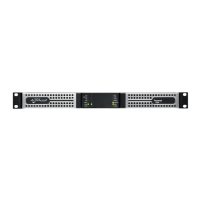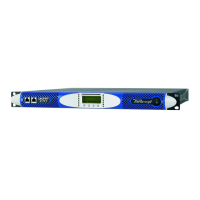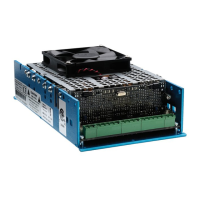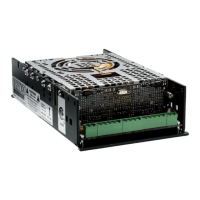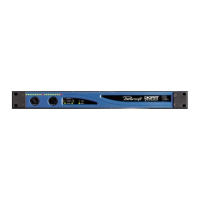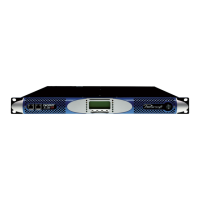▶
28
Duecanali User Guide
9 Network Operations
Network capabilities and network setting menus are available only
for Duecanali Series ampliers equipped with a KAESOP board.
KAESOP stands for K (as in Powersoft’s agship K Series) AES3 and
Ethernet Simple Open Protocol. Powersoft’s KAESOP is designed
to provide high reliability to live applications in harsh environments
where Quality Of Service must be guaranteed. Electromagnetic
and radio frequency interference (EMI and RFI) originating from a
high power audio and light system must not degrade audio quality
or cause a control link interruption. Moreover, a single cable or
device failure should not affect the overall system performance.
9.1 User’s introduction to AESOP
The AESOP standard can transport a single bidirectional Ethernet
100Mbps control data stream and two separate AES3 digital audio
monodirectional streams using one CAT-5 cable. All Duecanali
Series amplier with the optional KAESOP board installed are
equipped with at two RJ45 connectors, each a single AESOP port,
capable of sending and/or receiving data and audio. Ring, daisy
chain and a variety of network topologies are possible using the
dual port design implemented in all Duecanali Series ampliers.
9.1.1 Data stream
The data stream in the AESOP is implemented by a 100 Mbit
Ethernet connectivity with auto-sense. The dual port design in
Duecanali Series ampliers allows for daisy chain and redundant
ring topologies. A fault-bypass built in feature takes into account
the possibility of loosing an intermediate device or having a faulty
cable link without compromising the ring integrity. Each device can
use a static IP address assigned by the user. Alternatively, it can
be set to automatically congure itself without user intervention
following the Zeroconf protocol. The KAESOP board detects bad
quality connections by counting errors on the Ethernet control.
Faulty connections are automatically switched from 100Mbit/s to
10Mbit/s to attempt to keep the link active even in the worst
case scenarios. Please note that even if crossed Ethernet cables
would work control wise, crossed cables are NOT to be used for
KAESOP connections: they will not allow the AES3 streams to
ow correctly.
9.1.2 Audio
Audio is distributed to devices via the AESOP protocol by 2
independent and separate AES3 streams. These are carried by
two CAT-5 wire pairs unused in the 100 Mbit Ethernet protocol.
AES3 is a license free and well known standard guaranteeing low-
latency, high reliability and excellent audio quality. A single AES3
stream can carry a stereo audio signal. The AESOP protocol can
therefore handle four audio channels.
When a Duecanali Series amplier is powered off or if it is
unavailable, a passive high frequency relay circuit allows the audio
signal to pass through, preserving the network chain connection
integrity. When the device is powered up, the internal circuits
automatically select the most appropriate AES3 stream direction
and bypass the relay, re-buffering actively the AES3 signal. The
direction is maintained until errors are detected on the AES3
receiver circuit. When errors or link failure are detected, the
direction is swapped, to build-up a new path for the audio. In a
fraction of a second (no more than 50ms), some of the devices in a
ring will swap to the other direction, restoring the audio streaming.
9.1.3 Network connections: Ethernet, AES3 forwarding and
repeater modes
Each Duecanali Series amplier can be congured to handle the
pair of AES3 streams embedded in the AESOP protocol in one of
two basic network modes: repeater and forwarder. The following
section will describe these two different setups in detail. These
are true connection “building blocks”; it is therefore important
to understand these two modes thoroughly before attempting to
create or modify larger and more complex amplier networks.
The following are denitions of the terms used in this section:
▶
AES3-A STREAM, AES3-B STREAM: streams from the
AESOP CAT-5 network. Each stream can carry a stereo
audio signal.
▶
REAR AES3 STREAM: AES stream from the rear panel CH2
Phoenix with when the toggle button is in the AES/EBU
selected position.
▶
PORT 1, PORT 2: RJ45 AES3 and control ports
Ethernet internal switch
All control data streams in the KAESOP system are transported
via an Ethernet protocol. Inside all Duecanali Series ampliers is
an Ethernet switch connected to each RJ45. This means that the
bidirectional data stream can enter/exit one port and exit/enter
any other port, either alongside AES3 streams or on its own.
Internal routing of Ethernet networking is automatic and not user
controllable. An internal switch provides packet ooding block
services in order to allow building networks with a ring topology.
KAESOP repeater mode
In the “Repeater” mode, any AES3 stream received on port 1
will be repeated on port 2 and vice-versa: if the AES3 stream
is received on port 2 it will be repeated on port 1. This applies
to both AES stream A and AES stream B independently. If an
AES3 stream (A or B) is present as input at both RJ45 ports (this
can happen when a ring network topology is used), the internal
AESOP repeater feeds only one of the two identical streams
keeping the second stream in standby. If for some reason the rst
stream fails the second stream is used as a backup audio source.
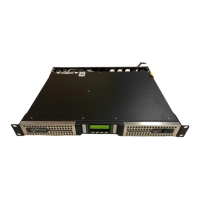
